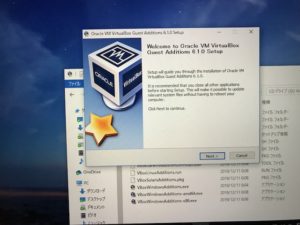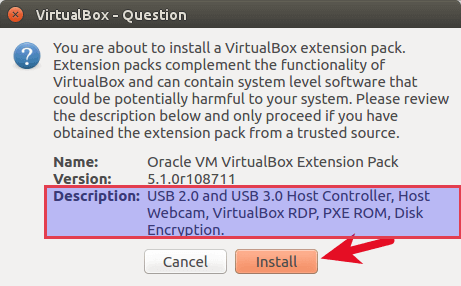Installation of CentOS as a guest OS is much like installing on real hardware. Start by downloading the ISO file[s] you wish to use for installation from a CentOS Mirror.

Creating a Virtual Machine

Thus, Oracle VM VirtualBox comes with extensive support for a substantial number of guest operating systems including, but absolutely not limited to, Mac OS X (10.5 or later), DOS/Windows 3.x, Linux (2.4 and 2.6), Windows (NT 4.0, 2000, XP, Server 2003, Vista, Windows 7), Solaris and OpenSolaris, OpenBSD, and OS/2. I was able to download the Guest Additions ISO for version 6.0.0 (running VBox 6.0.2) from here within the guest OS and install it (OS X Mojave) without any third party applications. I did so in an attempt to fix an issue I am having where I cannot release mouse capture, but unfortunately the guest additions did not help solve the issue. Macos-guest-virtualbox.sh is a Bash script that creates a macOS virtual machine guest on VirtualBox with unmodified macOS installation files downloaded directly from Apple servers. A default install only requires the user to sit patiently and, less than ten times, press enter when prompted by the script, without interacting with the virtual. I use VirtualBox to run multiple Linux VMs and also have no problem, it should be noted that Oracle do provide Guest additions for both Linux and Windows but not Mac. Hence my equation still applies. Oracle + Mac = ∞ x suckiness.
Create a New Virtual Machine (VM) with the Virtual Machine Wizard, choosing Linux for the OS Type and Red Hat or Red Hat (64 bit) for the Operating System. Memory should be at least 768MB for a graphical install to work. Next the virtual hard disk wizard will start. The OS disk should be at least 8GB. For a relatively full install, allocate at least 15GB, otherwise use all the defaults. Additional disk[s] can be added later if desired.
After the VM is created, run Settings, go to Storage, and under IDE Controller click on the CD icon on the left, then select the similar CD icon on the right and pick Choose a virtual CD/DVD from the list. Navigate to the directory where the ISO image[s] reside and pick one, for example CentOS-6.7-x86_64-LiveDVD.iso or CentOS-7-x86_64-DVD-1511.iso. Change any additional settings, such as the amount of memory for the virtual video adapter, and whether to use NAT or Bridged networking. For a first install attempt make a minimum of changes to the defaults.

Start the VM and perform a graphical install, or if desired a text install. After the install reboot and perform firstboot configuration.
Installing Guest Additions
You will need to be the root user for the following tasks. Login to a root shell or 'su -' in a terminal window.
The installation of VB will require the building of kernel modules. If DKMS (Dynamic Kernel Module Support) is installed it will be used and will simplify kernel upgrades. Installing DKMS from the EPEL repository is recommended before installing VirtualBox. Don't forget to configure the yum-priorities plugin. Installing DKMS may pull in required development dependencies, depending on the package source.
If DKMS is not used the Guest Additions will need to be reinstalled after every kernel update.

If the development environment and kernel source are not already installed:
You may also choose to only install a minimum set of individual development tool packages (at least gcc and make are required, in addition to kernel-devel) rather than the groupinstall which some may consider overkill. Replace 'kernel-devel' with 'kernel-PAE-devel' if using a PAE kernel on CentOS-5. If you are not using a standard CentOS kernel, you must acquire and install the source for your kernel from wherever you got the kernel. Do not try to install a Xen kernel in a Guest OS, or run KVM or any other nested virtualization hypervisor.
Virtualbox Guest Additions For Mac Os Guest
From the VM Devices menu select Install Guest Additions.... If running a GUI the virtual CD image for guest additions will automount - for instance under CentOS-6 with KDE it is mounted under /media/VBOXADDITIONS_5.0.14_105127. If autorun is enabled in a GUI you may get a window asking if you want to let the autorun execute, and asking for root authorization. Take all the defaults and the install should complete.
If not in a GUI, or if there is no autorun, as root mount /dev/cdrom or /dev/sr0 (if necessary) and cd to the mountpoint. Type ./VBoxLinuxAdditions.run to install.
Patch for specific CentOS version
Usually after a point release, which introduces major changes to the kernel or other subsystems, the compilation of the vBox tools fails. When such issues arise we will try to post applicable patches here, until this issue is fixed by vBox.
This page created by PhilSchaffner. Wiki contributors are invited to make corrections, additions, or modifications.
Virtualbox Macos Catalina Guest Additions
- 1 First Steps
- 1.4 Supported Host Operating Systems
- 1.8 Running Your Virtual Machine
- 1.10 Snapshots
- 1.14 Importing and Exporting Virtual Machines
- 1.15 Integrating with Oracle Cloud Infrastructure
- 1.18 Soft Keyboard
- 2 Installation Details
- 2.1 Installing on Windows Hosts
- 2.2 Installing on Mac OS X Hosts
- 2.3 Installing on Linux Hosts
- 2.4 Installing on Oracle Solaris Hosts
- 3 Configuring Virtual Machines
- 3.1 Supported Guest Operating Systems
- 3.2 Unattended Guest Installation
- 3.4 General Settings
- 3.5 System Settings
- 3.6 Display Settings
- 3.11 USB Support
- 3.14 Alternative Firmware (EFI)
- 4 Guest Additions
- 4.2 Installing and Maintaining Guest Additions
- 4.3 Shared Folders
- 4.4 Drag and Drop
- 4.5 Hardware-Accelerated Graphics
- 4.7 Guest Properties
- 4.8 Guest Control File Manager
- 4.10 Memory Overcommitment
- 4.11 Controlling Virtual Monitor Topology
- 5 Virtual Storage
- 5.11 vboximg-mount: A Utility for FUSE Mounting a Virtual Disk Image
- 6 Virtual Networking
- 6.3 Network Address Translation (NAT)
- 7 VBoxManage
- 7.8 VBoxManage modifyvm
- 7.10 VBoxManage import
- 7.11 VBoxManage export
- 7.37 VBoxManage unattended
- 7.38 VBoxManage snapshot
- 7.39 VBoxManage clonevm
- 7.40 VBoxManage sharedfolder
- 7.41 VBoxManage extpack
- 7.42 VBoxManage dhcpserver
- 7.43 VBoxManage debugvm
- 7.44 VBoxManage cloudprofile
- 7.45 VBoxManage cloud
- 7.46 VBoxManage signova
- 7.47 VBoxManage updatecheck
- 7.48 vboximg-mount
